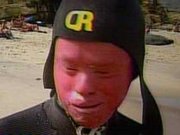Harlequin type ichthyosis
Harlequin type ichthyosis (also harlequin ichthyosis, ichthyosis congenita, or keratosis diffusa fetalis), the most severe form of congenital ichthyosis, is characterized by a thickening of the keratin layer in fetal human skin, appearing as massive, diamond-shaped scales. In addition, the eyes, ears, mouth, and other appendages may be abnormally contracted. The scaly keratin limits the child's movement, and because it is cracked where normal skin would fold, it is easily pregnable by bacteria and other contaminants, resulting in a serious risk of fatal infection. more...
Sufferers are known as harlequin fetuses, harlequin babies, or harlequins.
The harlequin type designation comes from both the baby's apparent facial expression and the diamond-shape of the scales (resembling the costume of Arlecchino), which are caused by severe hyperkeratosis. Seventeenth century entertainers known as jesters, or harlequins, wore costumes with diamond patterns on them, as well as a particular style of face paint. The features of the harlequin fetus resemble this stylized makeup, and their faces are often pulled tight into grim parodies of a clown's smile. The disease can be diagnosed in the womb by way of fetal skin biopsy.
Features
The features of sufferers are very deformed. The ears may be very poorly developed or absent entirely, as may the nose. The eyelids are severely inverted, which leaves the eyes and the area around them very susceptible to trauma. They often bleed upon birth. The lips, pulled by the dry skin, are fixed into a vestige of a clown's smile, which many find extremely disconcerting. Arms, feet, and fingers are almost always deformed in such a way that they cannot bend properly, and may be below the normal size. Polydactyly, a condition in which one has more than the usual number of toes or fingers, has also been found in these infants.
They are extremely susceptible to changes in temperature due to their plated skin, which prevents normal heat loss. This can result in hyperthermia. Their respiration is also restricted by the skin, which impedes the chest wall from expanding and drawing in enough air. This can lead to hyperventilation and respiratory failure. Harlequins are often dehydrated, as their plated skin is not well suited to keeping water in.
Treatment and prognosis
In the past, the disorder was invariably fatal, whether due to dehydration, infection, restricted respiration due to the armored plating, or other related causes. The most common cause of death is systemic infection. Therefore, practically all children did not survive for longer than a few days. However, there have been improvements in care, and some children have survived into adolescence and, in very rare cases, to adulthood; one has even become a triathlete . Because of this, the terms harlequin baby or just harlequin are now preferred over harlequin fetus. Treatment involves dosing with isotretinoin, the constant use of lotions to keep the skin supple, and use of a very high-calorie diet, including a feeding tube, required by the constant shedding of the skin, believed to shed seven to ten times faster than unaffected skin.
Genetics
Mutations in the ABCA12 gene cause harlequin ichthyosis. The ABCA12 gene makes a protein that is essential for the normal development of skin cells. Although the protein's exact function is unknown, researchers believe that it probably plays a major role in the transport of lipids (fats) in the outermost layer of skin (the epidermis). Mutations in the ABCA12 gene lead to the production of an abnormally small version of the protein that cannot transport lipids properly. The loss of functional ABCA12 protein disrupts the normal development of the epidermis, preventing the skin from forming an effective barrier and resulting in the hard, thick scales characteristic of harlequin ichthyosis.
Read more at Wikipedia.org



